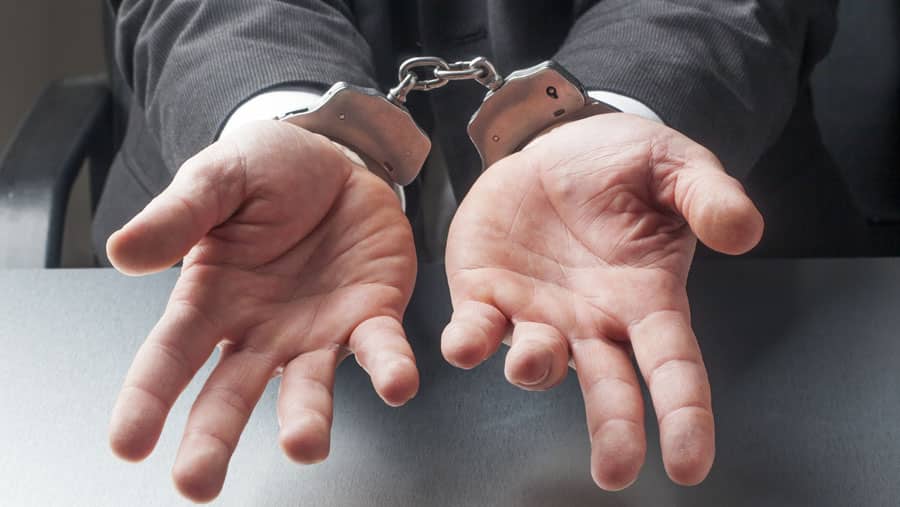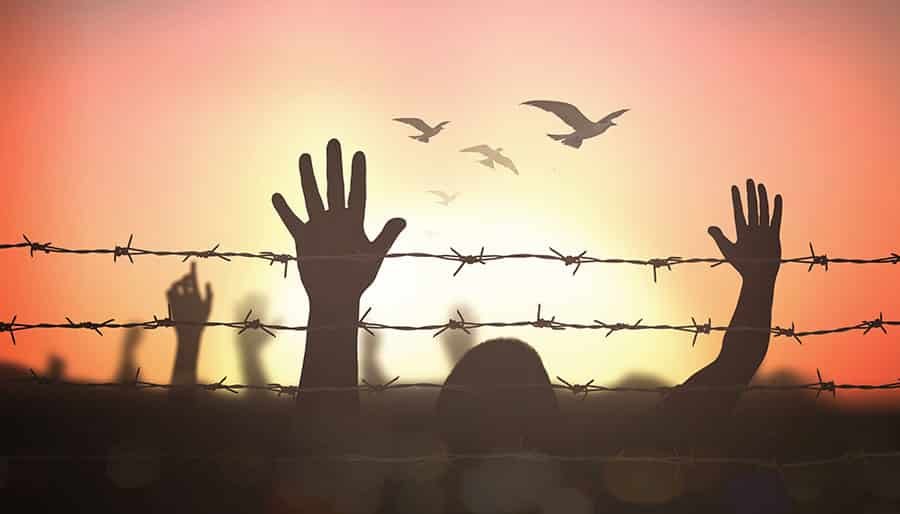John has been using drugs recreationally since middle school. That is, until he lost two people that meant the most to him. After that traumatic time, his drug use changed- it was like a switch had suddenly flipped in his head and something that was once a fun activity became one of the only things he looked forward to each day. It was as if, all of a sudden, he couldn’t remember what it felt like to wake up without craving a mind-altering escape.
John was an athlete in high school and mixed regular steroid use with just about anything that was being offered. Soon, he began to have a temper. After he graduated, he would palm a cocktail of opioids and uppers into his mouth, swallow, and then cringe. Eventually, John was arrested for possession of drugs and assault on a police officer. He punched a cop while under the influence.
Now, depending on everything from the local jurisdiction to state law to federal law, John can be sentenced to rehabilitation and probation or up to life in prison.

So much is left up to discretion- the discretion of the officer, of the prosecutor, the defense attorney, and the judge. The discretion of borders and which state-line you reside in. Which neighborhood you live in. Much of the US’s response to drug use is left in the hands of everyday individuals, individuals that may or may not be having a good day. Individuals that often have little to no personal experience with drug abuse or addiction.
If this sends a chill down your spine, you’re in good company. We’re here to examine the differences in effectiveness between incarceration and rehabilitation at a drug and alcohol treatment center.
The War On Drugs
President Nixon and the US government first initiated the war on drugs in 1971. Soon enough, nations adopted this mission as well. The war on drugs began with a strong liking for harsh punitive sentences to dissuade an individual from deciding to use illegal substances.
This fear-driven concept dominated the response of legal officials and of drug use and drug-related crimes from the ’80s into the new millennia. Fear-based preventative measures and punishment were the precedents until, in the early 21st century, study after study showed that harsh sentences and the criminalization of all drugs did not reduce drug use. In fact, it tended to lead to a host of other problems that negated the original intent.
Quick Statistics
As of May 2020, 450,000 people are incarcerated for a nonviolent drug offense, according to the Prison Policy Initiative.
Of the 157,000 people that are in local jails, 120,000 people have not been convicted of any crime.
This is the reality of the current judicial system pertaining to illegal substances. Several illicit drugs that would typically result in a ticket and a program in California can change the course of someone’s life in Texas. The cash bail system sees thousands of people accused of nonviolent crimes incarcerated without a fair trial, many sitting in jail awaiting a court date that will fluctuate depending on the court’s caseload.

Study after study shows that the war on drugs and its harsh, punitive sentences for drug users does not work. The thing that does work? Harm reduction tactics and judge-appointed drug rehabilitation.
Harm Reduction (HR) Vs. War On Drugs (WOD)
In a study published by the US National Library of Medicine and the National Institutes of Health, researchers found that countries that implemented a Harm Reduction (HR) approach rather than a War on Drugs (WOD) approach saw a greater impact on public health.
“The results showed that despite the expectations, the strict approach [of WOD] did not have positive results about abuse and relapse reduction,” the 2019 study states.
The HR approach was evidence-based while the WOD approach proved to be influenced by more archaic ideologies. That is to say, the HR approach was constructed out of substantiated programs while the WOD approach had been influenced by the public and political perception of drug use (and originated when drug use was much less understood in the scientific community).
This study also concluded that Harm Reduction, which incorporated health-based policies and emphasized rehabilitation, was more successful than the War on Drugs approach, which aimed to punish those involved with illicit substances.
According to data collected and reported by the US Department of Justice, around 65% of inmates currently have a Substance Use Disorder (SUD), compared to 5% of the general population (these statistics are pre-quarantine so that may have gone up a little bit).
When the United States prison system costs taxpayers at least 80 billion dollars per year, you can’t help but wonder what might work better for those suffering from addiction in our community.
Drug And Alcohol Treatment in Prison
The War on Drugs has seen a significant rise in the prison population, with nearly half a million people serving time for nonviolent drug offenses as of 2020. This has led to the need for drug programs that operate from within penal institutions. These programs are built around cognitive behavioral therapy, a type of therapy that focuses on repositioning internal thought and perspective in its relation to the world.
Some prisons also offer residential programs and group therapy, both of which are important parts of substance abuse treatment. These programs have proven to be effective, according to the Department of Justice, if they are implemented correctly. ‘Implemented Correctly’ being the key phrase.
Research by the American Public Health Association found that only about 11% of those in prison that are struggling with a Substance Use Disorder are actually treated for it.

According to the study cited by the APHA, “the center’s second report on the topic found that of the 2.3 million U.S. inmates, 1.5 million suffer from substance abuse addiction and another 458,000 inmates either had histories of substance abuse, were under the influence of alcohol or other drugs at the time of committing their crimes; committed their offenses to get money to buy drugs; were incarcerated for an alcohol or drug violation.” 2010
These two groups comprise more than 80% of the US prison population as a whole, with only 11% of those with current substance addictions being treated for them.
A study published in 2012 found that if just 10 percent of inmates with drug offenses [drug-related crimes] were sent to treatment centers instead of being incarcerated, $4.8 billion could be saved compared to the practices currently put in place in the criminal justice system.
– Lifetime Benefits and Costs of Diverting Substance-Abusing Offenders From State Prison
What Rehabilitation Has To Offer
Drug rehabilitation has proven to be the most effective treatment for someone with a substance use disorder (SUD). Many rehabilitation centers offer the same services as government-mandated programs and incorporate effective modalities such as cognitive behavioral therapy (CBT) and group therapy into their treatment program while also offering a wide variety of other effective therapies. The diverse treatment landscape offered in the rehabilitation industry ensures that people overcoming addiction are given an individual program that addresses the needs of each client respectively.
Hotel California By The Sea facilities offer cognitive behavioral therapy along with dialectical behavioral therapy (DBT), an evidence-based psychotherapy that focuses on influencing behavioral patterns and substance abuse through tangible practices.
“[Dialectical behavioral therapy] treats a lapse into substance abuse as a problem to solve, rather than as evidence of patient inadequacy or treatment failure,” according to research published by the US National Library of Medicine and the National Institutes of Health.
HCBTS also offers EMDR (short for Eye Movement Desensitization and Reprocessing), a nontraditional psychotherapy treatment that has risen in popularity over the last decade for the treatment of Post-Traumatic Stress Disorder (PTSD). EMDR uses a patient’s rapid eye movement and rhythm to help them process traumatic events and the unhealthy associations resulting from those specific memories. This treatment has proven to be effective for clients that are struggling with PTSD along with their addiction.
Our treatment centers offer the more traditional treatments as well, such as 12-step programs and group therapy for substance abuse. HCBTS strives to offer as many effective programs to our clients as possible to ensure a customized and beneficial treatment program.
Rehab For People Who Have Been Incarcerated
HCBTS welcomes anyone looking to overcome their addiction. We do not discriminate against people based on their criminal record. The judicial system is expensive and the cost of rehab is one of the greatest barriers to treatment for those with a prior conviction.
Hotel California By The Sea’s treatment center network was designed to break down the financial barrier for as many of our clients as possible. We do whatever it takes to make drug and alcohol recovery accessible and affordable for everyone.
It’s time to acknowledge what works: compassionate and highly structured drug addiction treatment for those suffering from a substance use disorder – whether they’ve gotten caught up in legal trouble, or not.
Sometimes, one of the consequences of the disease of addiction is legal problems. Although we provide traditional therapeutic treatment for addiction, we also offer separate services for patients who need help navigating the judicial systems. At HCBTS, we can help guide clients through the ins and outs of topics such as warrants, hearings, drug court, probation, and more. We’re here to help you in every area of your life when you walk through our doors.

Hotel California by the Sea accepts most health insurance plans. Our professional team of admissions personnel are available 24/7 to answer any questions you may have about the affordability of the programs we offer.
Every call is free and completely confidential. (800) 762-6717. For a comprehensive list of the insurance carriers we accept, click here.
